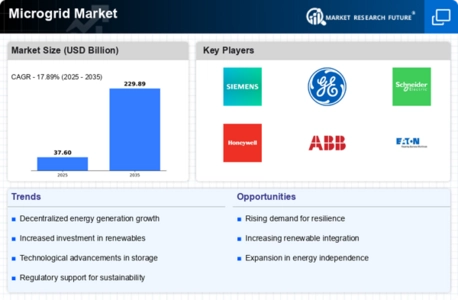Growing Need for Energy Resilience
The escalating need for energy resilience is a significant driver for the Microgrid Market. As extreme weather events and natural disasters become more frequent, communities are increasingly seeking solutions to ensure uninterrupted power supply. Microgrids offer localized energy generation and distribution, which can operate independently from the main grid during emergencies. In 2025, the demand for resilient energy solutions is expected to rise, with many regions prioritizing investments in microgrid technologies. This trend underscores the importance of microgrids in enhancing energy security and reliability, positioning the Microgrid Market as a vital component in the broader energy landscape.
Rising Demand for Renewable Energy
The increasing emphasis on renewable energy sources is a pivotal driver for the Microgrid Market. As nations strive to meet ambitious climate goals, the transition from fossil fuels to renewable energy is accelerating. In 2025, it is estimated that renewable energy could account for over 30 percent of the total energy mix in various regions. This shift not only reduces greenhouse gas emissions but also enhances energy security. Microgrids, which can integrate diverse renewable sources such as solar, wind, and biomass, are becoming essential in this transition. The Microgrid Market is thus witnessing a surge in demand as communities and businesses seek to harness local renewable resources, ensuring a more sustainable and resilient energy future.
Technological Advancements in Energy Storage
Technological innovations in energy storage systems are significantly influencing the Microgrid Market. The development of advanced battery technologies, such as lithium-ion and flow batteries, has improved the efficiency and reliability of energy storage solutions. In 2025, the energy storage market is projected to reach a valuation of approximately 200 billion dollars, with a substantial portion attributed to microgrid applications. These advancements enable microgrids to store excess energy generated from renewable sources, ensuring a stable power supply even during peak demand or outages. Consequently, the Microgrid Market is likely to expand as more entities recognize the value of integrating robust energy storage solutions into their microgrid systems.
Supportive Government Policies and Incentives
Supportive government policies and incentives are instrumental in driving the Microgrid Market. Many governments are implementing favorable regulations and financial incentives to promote the adoption of microgrid technologies. In 2025, it is projected that various countries will offer tax credits, grants, and subsidies to encourage investments in microgrid projects. These initiatives not only lower the financial barriers for stakeholders but also stimulate innovation within the industry. As a result, the Microgrid Market is likely to experience accelerated growth, as more entities take advantage of these supportive measures to develop and deploy microgrid solutions.
Increased Investment in Smart Grid Infrastructure
Investment in smart grid infrastructure is a crucial driver for the Microgrid Market. Governments and private entities are increasingly allocating funds to modernize aging electrical grids, which enhances the integration of microgrids. In 2025, it is anticipated that investments in smart grid technologies will exceed 100 billion dollars, reflecting a growing recognition of the need for resilient and efficient energy systems. Smart grids facilitate real-time monitoring and management of energy resources, allowing microgrids to operate more effectively. This trend not only supports the deployment of microgrids but also fosters innovation in energy management solutions, thereby propelling the Microgrid Market forward.



.webp)
.webp)
.webp)
.webp)
.webp)
.webp)








Leave a Comment